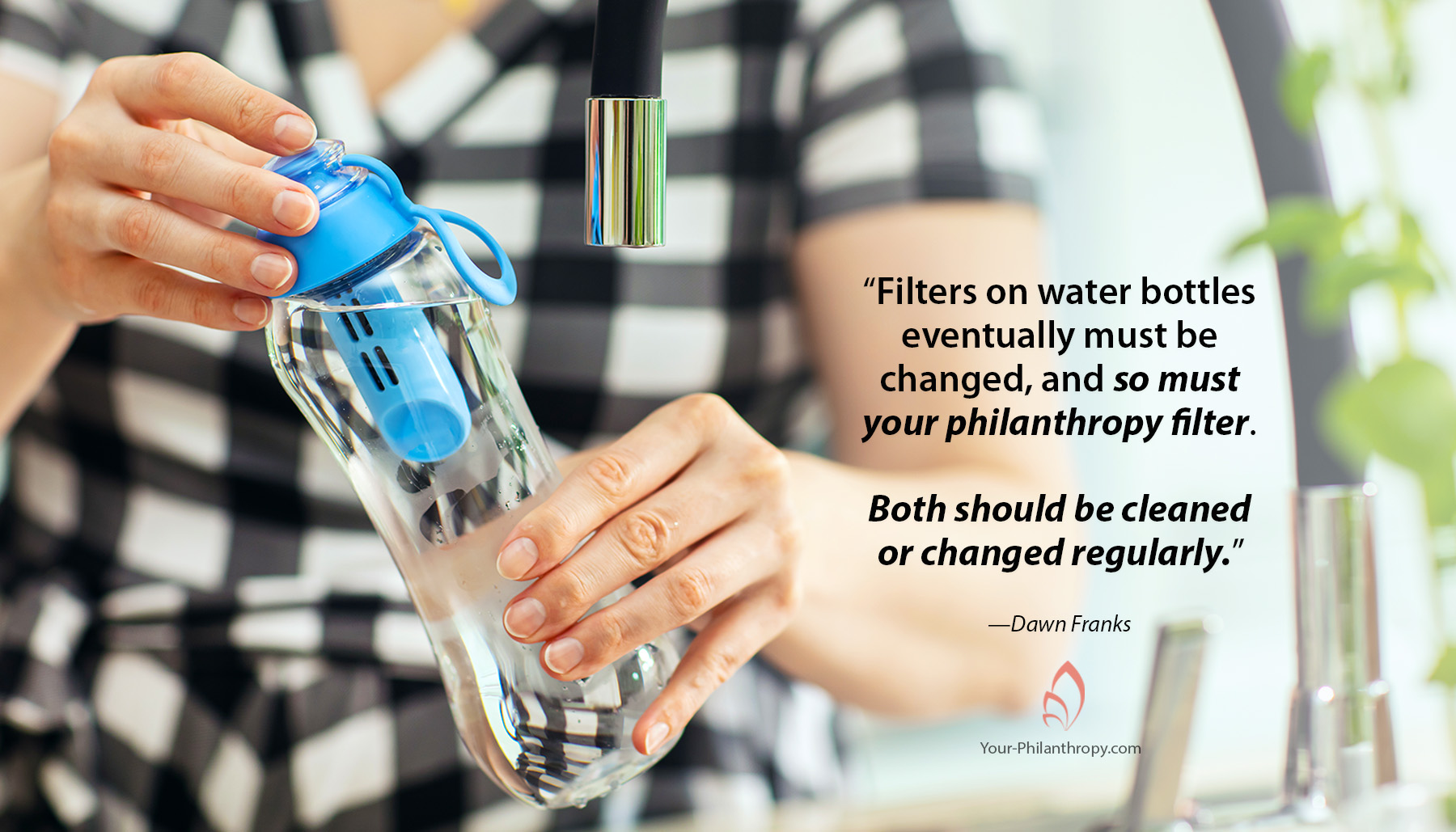How does it feel to be a philanthropist today? It might be tempting to assume that question only applies to the wealthy donor who can write large checks year after year. When in fact, the question is for you. Comparing ourselves against others who give more or less does not make us better givers.
Your giving journey is yours alone. You may not be entirely alone on the giving path. Perhaps you and your spouse make giving decisions together, or you engage your children – young or old – in giving decisions. Even so, how you feel about giving and what you learn on the journey begins with your personal filter system.
How you filter information about your favorite nonprofit organization or an issue you care about is yours alone. But, based on a lifetime of experiences – your experiences – you will have opinions and questions worth asking. Your filters might be simple or multi-layered, like those found in filtered water bottles on the market today.
How complicated could a filter be in a simple water bottle? Well, it’s not as simple as it looks. First, there are various filtering systems with varying materials and layers in the bottle’s filter. Ease of use and clean-up is not evident from the looks of the bottle. Then there’s the matter of the bottle itself, stainless steel, or plastic. The result, of course, is all about taste. Does it taste clean; is it odorless and refreshing?
Like the complex water bottle filter, your giving decisions filter through questions, stories, opinions and sources of information. Your philanthropy filter system helps you identify the best match for your giving. It also helps you know what to avoid.
Three Questions for Your Philanthropy Filter System
1. Is the nonprofit organization focused on services or work that is achievable?
If the organization is constantly introducing new ideas, new services, or new directions, be cautious. They may be fishing for donors rather than delivering well-thought-out, needed services, and attracting donors who support the work for the long haul.
2. What do you know about the executive leadership of the nonprofit?
Last month Margie Boyd, recently named Executive Vice President of Your Philanthropy, wrote a blog that identified eight characteristics of a nonprofit leader. To ignore the importance of executive leadership at any nonprofit organization is like writing a check blindfolded. Read it here How to Build Lasting Partnerships with the Greatest Impact
3. Does the nonprofit organization have a sustainable operating model?
If a nonprofit organization frequently appeals for donations to keep its doors open, you might question its ability to ride the ups and downs of the typical fundraising rollercoaster. But, without a doubt, some years are better than others for almost all nonprofit organizations.
If a nonprofit organization frequently appeals for donations to keep its doors open, you might question its ability to ride the ups and downs of the typical fundraising rollercoaster. But, without a doubt, some years are better than others for almost all nonprofit organizations.
If you’re a frequent donor and listen when they communicate, you will know the difference. You will know when a more significant donation is needed. Avoid those that are always on the edge of a crisis.
One caveat today: many organizations continue to be challenged by the impact of Covid-19 and the ability to fundraise in their typical manner. Know the difference – that’s your philanthropy filter at work.
When a New Filter is Required – Bonus Question
Are you giving to issues and nonprofit organizations that fit your giving values – Your Giving Fingerprints?
I frequently talk about the importance of being true to your giving values. I have not altered my belief on the subject. But I recognize that there is a moment of reckoning for all of us with children. If you’re encouraging the next generation – your children, grandchildren, nieces, and nephews – to learn to give, you may find their values quite different. Or, they may have motivations that leave you baffled. They will have different sources of information as disconcerting as they are puzzling. You will know when you arrive at this point; changes to your filtering system are imminent.
Don’t be afraid of change. Be afraid of becoming too comfortable, assuming organizations and issues important to you are the same today as yesterday. Filters on water bottles eventually must be changed, and so must your philanthropy filter. Both should be cleaned or changed regularly.
Even nonprofit organizations steadfastly serving must adjust, shift, or morph their services to effectively respond to who and what is most needed. When your philanthropy filtering system works properly you will recognize the importance of such changes.
Remember, your philanthropy filter is yours, alone. It will not be exactly like anyone else’s system. Trust your filters to guide you to the best giving decisions possible.
What kind of philanthropy filter do you use? What guides your decision-making?
Like it? Use it. Share it. Comment below.


0 Comments